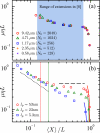Mobility of a semiflexible chain confined in a nanochannel
- PMID: 23003659
- PMCID: PMC3503239
- DOI: 10.1103/PhysRevLett.108.228105
Mobility of a semiflexible chain confined in a nanochannel
Abstract
The classic results of de Gennes and Odijk describe the mobility of a semiflexible chain confined in a nanochannel only in the limits of very weak and very strong confinement, respectively. Using Monte Carlo sampling of the Kirkwood diffusivity with full hydrodynamic interactions, we show that the mobility of a semiflexible chain exhibits a broad plateau as a function of extension before transitioning to an Odijk regime, and that the width of the plateau depends on the anisotropy of the monomers. For the particular case of DNA in a high ionic strength buffer, which has highly anisotropic monomers, we predict that this Rouse-like behavior will be observed over most of the measurable chain extensions seen in experiments.
Figures


References
-
- Daoud M, de Gennes P-G. J. Phys. (Paris) 1977;38:85.
-
- de Gennes P-G. Scaling Concepts in Polymer Physics. Cornell University Press; Ithaca, NY: 1979.
-
- Brochard F, de Gennes P-G. J. Chem. Phys. 1977;67:52.
-
- Odijk T. Macromolecules. 1983;16:1340.
Publication types
MeSH terms
Substances
Grants and funding
LinkOut - more resources
Full Text Sources
Other Literature Sources
